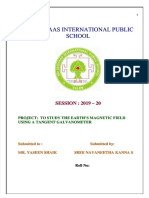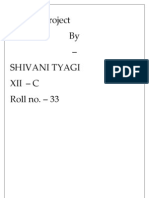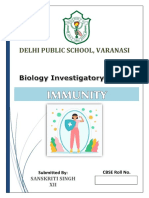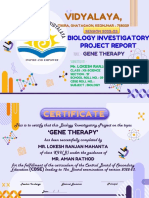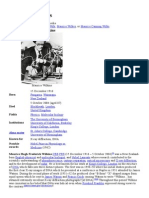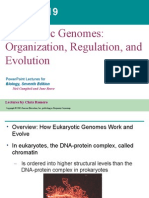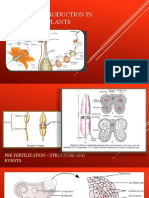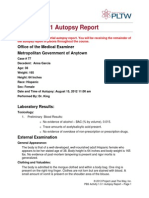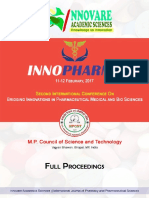Professional Documents
Culture Documents
The Rice Genome Project PDF
The Rice Genome Project PDF
Uploaded by
Nilpa PatelOriginal Description:
Original Title
Copyright
Available Formats
Share this document
Did you find this document useful?
Is this content inappropriate?
Report this DocumentCopyright:
Available Formats
The Rice Genome Project PDF
The Rice Genome Project PDF
Uploaded by
Nilpa PatelCopyright:
Available Formats
THE RICE GENOME PROJECT
International Rice Genome Sequencing Project (IRGSP)
The International Rice Genome Sequencing Project (IRGSP) is a consortium of publicly
funded laboratories. I was established in 1997 to obtain high quality, map – based sequence of the
rice genome. It is currently comprised of ten members: Japan, the United States of America, China,
Taiwan, Korea, India, Thailand, France, Brazil and the United Kingdom. The IRGSP adopts the
clone- by- clone shotgun sequencing strategy so that each sequenced clone can be associated with a
specific position on the genetic map. It adheres to the policy of immediate release of the sequence
data to the public domain. In December 2004, the IRGSP completed the sequencing of the rice
genome. The high-quality and map – based sequence of the entire genome is now available in
public databases.
Rice is one of the world’s most important food plants. It is a model plant for the grasses. It
has important syntenic relationships with other cereal species. Rice is a monocarpic annual plant
that usually grows between 1 and 1.8 meters tall. It has long slender leaves 50-100 cam long and 2
– 2.5 cm broad. Its small wind-pollinated flowers are characteristic of grasses. The seed is a grain
normally 5-12 mm long and 2-3 mm thick. Rice is the world’s first genome of a crop plant that was
completely sequenced.
Varieties of Rice
There are three main varieties of Oryza sativa:
i) Indica: This variety is long-grained, e.g., Basmati rice, grown mainly on the Indian
subcontinent.
ii) Japonica: Japonica rice is short-grained and high in amylopectin (thus becoming
‘sticky’ when cooked), and is grown mainly in more temperate and colder regions such as
Japan.
iii) Javonica: Javonica rice is broad- grained and grown in tropical climates.
Rice a Model Experimental Crop
Rice is a model experimental cereal plant belonging to the grass family. It has relatively
short generation time. It has a much smaller genome and the greatest biodiversity of cereal crops. It
has a high degree of collinearity with the genomes of wheat, barley and maize. Rice exhibits
substantial conservation of gene order (synteny).
‘Gene, the blueprint of life’, is the most precious propriety in biotechnology and agriculture.
Genome often allows prediction of gene position across cereals. Rice has a simple genetic system
(diploid and disomic inheritance). It has enormous number of genes controlling agronomically
important traits. Wide genetic diversity is present in the genus Oryza. The rice genome is well
mapped and well characterized by small size of its genome, estimated 400 to 430 Mb. The rice
genome holds fundamental information in its biological ‘power’ including physiology,
development, genetics and molecular evolution.
Milestone in Rice Genome Sequencing
• Sept. 1997 – Sequencing of the rice genome was initiated as an international collaboration
among 10 countries.
• Feb. 1998 – IRGPS launched under coordination of RGP (Rice Genome Program) of Japan.
• April 2000 – Monsanto Co. produced a draft sequence of BAC covering 260Mb of the rice
genome; 95% of rice genes were identified.
• Feb. 2001 – Syngenta produced a draft sequence and identified 32,000 to 50,000 genes,
99.8% sequence accuracy and identified 99% of the rice genes.
• Dec. 2002 – IRGSP finished high- quality draft sequence (clone-by-clone approach) with a
sequence length, excluding overlaps, of 366 Mb corresponding to ~ 92% - rice genome.
• Dec. 2004 – IRGSP produce the high-quality sequence- entire rice genome; with 99.9%
accuracy and without any sequence gap.
The size (in Mbp) and predicted number of genes for each chromosome from rice
Chromosome Size (Mb) Predicted Number of Genes
Chr 1 45.1 4467
Chr 2 36.8 3011
Chr 3 37.3 3197
Chr 4 35.9 2679
Chr 5 30.0 2426
Chr 6 32.1 2342
Chr 7 30.4 2507
Chr 8 28.5 2286
Chr 9 23.8 1618
Chr 10 23.7 1724
Chr 11 30.8 1834
Chr 12 27.8 1870
Mitochondria 0.491 96
Chloroplast 0.135 159
Total ~ 383 Mb 30216
Indian participation on Rice Genome Sequence
The IRGSP initiated in Japan in 1997 and the project estimated to cost about $200 million.
India joined IRGSP in June 2000 and chose to sequence a part of chromosome 11. India has
invested Rs. 48.83 crores for the “Indian Initiative for Rice Genome Sequencing” (IIRGS). The
initiative is a joint effort by the Department of Plant Molecular Bio9logy (DPMB), University of
Delhi South Campus and the National Research Centre on Plant Biotechnology (NRCPB) and the
Indian Agricultural Research Institute (IARI), New Delhi. The Indian share of chromosome 11 has
been equally divided between these two centres. It was known to carry several disease resistant
genes including Xac1 bacterial blight resistant gene – selected finding: chromosome segment
sequenced by IARI involve 6.825 million bp and predicted 1005 gene - with unknown function.
Facts about the sequencing of Rice Genome
• The rice genome is about 389 mb, 370.7 Mb has been sequenced, 18.1 Mb unsequenced.
• Sequenced segment represents 99% of euchromatin and 95% of rice genome.
• The rice genome has approximately 40,000 to 60,000 genes (37,344 coding genes).
• One gene can be found every 9.9 kb, a lower gene density than that observed in Arabidopsis.
• 29% in clustered gene families.
• 2,859 genes seem to be unique to rice and the other cereals, some of which might
differentiate monocot and dicot lineages.
• Between 0.38 and 0.43% of the nuclear genome contains organellar DNA fragments,
representing repeated and ongoing transfer of organellar DNA to the nuclear genome.
• Repetitive DNA is estimated to constitute at least 50% of the rice genome.
Application and Impact of Rice Genome Sequence
• Understanding – plant evolution and the differences between monocots and dicots.
• Improve efficiency of rice breeding.
• Improve nutritional value of rice.
• Enhance crop yield by improving seed quality, resistance to pests and diseases and plant
hardiness.
• Useful in identifying plant specific genes that can be potential herbicide targets.
• Development of gene-specific markers for marker-assisted breeding of new and improved
rice varieties.
Reasons for sequencing Rice first
• Importance as crop.
• Largest food source for poor.
• Feeds half of world’s population.
• Demand likely to increase dramatically.
• In Asia alone, demand will increase by at least 35%.
You might also like
- Peppered Moth Gizmo - Answer KeyDocument4 pagesPeppered Moth Gizmo - Answer KeyDareea Tate30% (10)
- Biology Investigatory ProjectDocument16 pagesBiology Investigatory Projectth1nv2r75% (4)
- The Determination of The Amount of Phosphate in A DetergentDocument8 pagesThe Determination of The Amount of Phosphate in A DetergentHarish Parthasarathy0% (1)
- English Project PDFDocument14 pagesEnglish Project PDFSpoorthi Raju Shetty25% (4)
- ABO Blood Grouping Cbsebiology4uDocument14 pagesABO Blood Grouping Cbsebiology4uRahit BiswasNo ratings yet
- Rice Genome ProjectDocument20 pagesRice Genome ProjectRanjith MuralidharanNo ratings yet
- To Study The Earths Magnetic Field Using A Tangent GalvanometerDocument20 pagesTo Study The Earths Magnetic Field Using A Tangent GalvanometerYASH VARDHAN SINGHNo ratings yet
- Chemistry Sahodaya PaperDocument10 pagesChemistry Sahodaya PaperflippodynamicsNo ratings yet
- Development in Rice Genome ResearchDocument11 pagesDevelopment in Rice Genome ResearchAGNIK KUNDUNo ratings yet
- Chemistry Investigatory ProjectDocument23 pagesChemistry Investigatory ProjectLoveansh BasantwaniNo ratings yet
- Biology ProjectDocument8 pagesBiology ProjectShivani Tyagi67% (6)
- Biology Investigatory ProjectDocument26 pagesBiology Investigatory ProjectVVM. S.4669No ratings yet
- Biology Investigatory Project 2019-20 Jawahar Navodaya Vidyalaya JharsugudaDocument12 pagesBiology Investigatory Project 2019-20 Jawahar Navodaya Vidyalaya JharsugudaAbhaya Badi0% (1)
- Physics ProjectDocument25 pagesPhysics Projectaryan sharrma100% (1)
- Wa0002.Document17 pagesWa0002.Rudra Patel100% (1)
- Investigatory Project On: Recombinant DNA Technology in Todays MedicineDocument19 pagesInvestigatory Project On: Recombinant DNA Technology in Todays MedicineDivyanka Kumari100% (1)
- Chemistry Investigatory ProjectDocument26 pagesChemistry Investigatory ProjectNIKHIL DWIVEDI100% (1)
- To Study Oxalate Ion in GuavaDocument15 pagesTo Study Oxalate Ion in Guavasureshkumar ChemNo ratings yet
- Chemistry Investigatory Project Class 12Document11 pagesChemistry Investigatory Project Class 12Arun kumarNo ratings yet
- Bio Ivestigatory Project PDFDocument85 pagesBio Ivestigatory Project PDFkirubak729No ratings yet
- Biology Investigatory ProjectDocument14 pagesBiology Investigatory Projectzahir khanNo ratings yet
- Biology Investigatory ProjectDocument4 pagesBiology Investigatory ProjectAnuj Patil0% (1)
- OUAT UG Rank CardDocument1 pageOUAT UG Rank CardChiranjeeb hota0% (1)
- Sotyo Proko Blic School: TopicDocument15 pagesSotyo Proko Blic School: TopicYahyouknowme100% (1)
- Biology Investigatory Project Class XII 2.ODocument25 pagesBiology Investigatory Project Class XII 2.OYash WardhanNo ratings yet
- Bioo ProjectDocument32 pagesBioo ProjectSANSKRITI 3928No ratings yet
- BIOLOGy Covid 19 ProjectDocument28 pagesBIOLOGy Covid 19 Projectyash100% (2)
- Exp - 8 PN JunctionDocument3 pagesExp - 8 PN JunctionpooshkarrNo ratings yet
- Musical Bell CircuitDocument5 pagesMusical Bell CircuitAnimesh Singh100% (1)
- Presence of Oxalate Ions in Guava Chemistry Investigatory Project PDFDocument11 pagesPresence of Oxalate Ions in Guava Chemistry Investigatory Project PDFSanjay Chauhan100% (1)
- Physics Investigatory ProjectDocument18 pagesPhysics Investigatory ProjectAvani GuptaNo ratings yet
- To Estimate Charge On Pith Ball Class XIDocument17 pagesTo Estimate Charge On Pith Ball Class XIAbhishek Mahapatro100% (1)
- Hariom Kumar RoyDocument24 pagesHariom Kumar RoyRajeev Kumar Roy0% (1)
- BiopracticalDocument51 pagesBiopracticalSourav joshiNo ratings yet
- Chemistry Investigatory Project Darsh JainDocument16 pagesChemistry Investigatory Project Darsh JainASHU KNo ratings yet
- Kendriya Vidhyalay NO. 2 Biology Investigatory Project: Topic-Microbes in Human WelfareDocument25 pagesKendriya Vidhyalay NO. 2 Biology Investigatory Project: Topic-Microbes in Human WelfareVaishnavi SongaraNo ratings yet
- Comparative Study of Rate of FermentationDocument31 pagesComparative Study of Rate of FermentationAkash0% (1)
- Phy ProjectDocument15 pagesPhy ProjectLohith 4321No ratings yet
- BIOLOGY INVESTIGATORY PROJECT Class 12Document21 pagesBIOLOGY INVESTIGATORY PROJECT Class 12SNIGDHA APPANABHOTLANo ratings yet
- The Effect of Oil Spills On OceansDocument12 pagesThe Effect of Oil Spills On OceansfardheenNo ratings yet
- Kendriya Vidyalaya Ambarnath Physics Investigatory ProjectDocument22 pagesKendriya Vidyalaya Ambarnath Physics Investigatory ProjectROHIT SIHRA100% (2)
- Biology Project File Alzheimer: Akshita AgrawalDocument15 pagesBiology Project File Alzheimer: Akshita AgrawalAkshita100% (1)
- Acidity of Fruit and Vegetable JuiceDocument11 pagesAcidity of Fruit and Vegetable Juicekanha kumarNo ratings yet
- Biology Investigatory Project 121126091042Document12 pagesBiology Investigatory Project 121126091042ajitsingh220867% (3)
- English Project FinalDocument27 pagesEnglish Project FinalVirendra NaikNo ratings yet
- Class 12 Chemistry Practical by Bharat PanchalDocument34 pagesClass 12 Chemistry Practical by Bharat PanchalSarita BhattNo ratings yet
- 12th Biology Investigatory ProjectDocument17 pages12th Biology Investigatory ProjectAneesh Chauhan100% (1)
- Kalyan Chemistry 2Document13 pagesKalyan Chemistry 2Divyanshu PotaliyaNo ratings yet
- Physics Investigatory (Lenz Law)Document14 pagesPhysics Investigatory (Lenz Law)alirizvi76786050% (2)
- Chemistry Investigatory Project ABSDocument18 pagesChemistry Investigatory Project ABS11th Batch LegendzNo ratings yet
- Abhinav Prabhakar Chemistry Project CLASS 12FDocument20 pagesAbhinav Prabhakar Chemistry Project CLASS 12FSumedhaNo ratings yet
- Recombinant DNA Technology in Todays MedicineDocument17 pagesRecombinant DNA Technology in Todays MedicineShailesh100% (1)
- Lead Nitrate Salt AnalysisDocument2 pagesLead Nitrate Salt AnalysisSantosh Kumar Sahu0% (1)
- Physcs 2Document24 pagesPhyscs 2Parv KhandelwalNo ratings yet
- Chemistry: Investigatory Project On Food AdulterationDocument18 pagesChemistry: Investigatory Project On Food AdulterationZobiya KhanNo ratings yet
- Bio ProjectDocument23 pagesBio ProjectKarthika Umashankar57% (7)
- Biology INVESTIGATORY PROJECT REPORT ON GENE THERAPYDocument32 pagesBiology INVESTIGATORY PROJECT REPORT ON GENE THERAPYLokesh Ranjan Mahanta100% (1)
- Chemistry Investigatory ProjectDocument18 pagesChemistry Investigatory ProjectWoah NitinNo ratings yet
- CROP Genome ProjectsDocument27 pagesCROP Genome ProjectsAnkNo ratings yet
- The Biotron Breeding System A Rapid and Reliable P PDFDocument10 pagesThe Biotron Breeding System A Rapid and Reliable P PDFAndres OrdoñezNo ratings yet
- Rice GenomeDocument26 pagesRice GenomePavani Gaja100% (1)
- Genetic: Introduction To Genetic AlgorithmsDocument44 pagesGenetic: Introduction To Genetic AlgorithmsMeyer Al-HayaliNo ratings yet
- 14 Gene Expression Transcription SDocument6 pages14 Gene Expression Transcription SHelp Me Study TutoringNo ratings yet
- 13 Cellular Respiration-KEYDocument7 pages13 Cellular Respiration-KEYNicholas SchmidtNo ratings yet
- Test Request Form - (Name Laboratory) : Patient Details Requester DetailsDocument1 pageTest Request Form - (Name Laboratory) : Patient Details Requester DetailsDjdjjd SiisusNo ratings yet
- Impact of Eukaryotic Translation Initiation FactorDocument19 pagesImpact of Eukaryotic Translation Initiation FactorMilorad ZjalićNo ratings yet
- Maurice WilkinsDocument15 pagesMaurice Wilkinsmenilanjan89nLNo ratings yet
- Eukaryotic Genomes: Organization, Regulation, and Evolution: Powerpoint Lectures ForDocument66 pagesEukaryotic Genomes: Organization, Regulation, and Evolution: Powerpoint Lectures Forxo_simpledreamNo ratings yet
- PDF - Pedigree WorksheetDocument2 pagesPDF - Pedigree Worksheetapi-280769158100% (3)
- Genetic Engineering AnswersDocument2 pagesGenetic Engineering AnswersVirginia MorleyNo ratings yet
- Malaria (Table of Characteristics)Document1 pageMalaria (Table of Characteristics)Noelle Grace Ulep BaromanNo ratings yet
- Heredity Practice Problems 1-3Document4 pagesHeredity Practice Problems 1-3api-589105124No ratings yet
- Class 9th MCQsDocument8 pagesClass 9th MCQsAmit PratapNo ratings yet
- General HistologyDocument7 pagesGeneral Histology05021966No ratings yet
- Sexual Reproduction in Flowering PlantsDocument46 pagesSexual Reproduction in Flowering PlantsNishita BharaliNo ratings yet
- (Doi 10.1007 - 978!3!662-05204-4) Mirsky, Vladimir M. - (Springer Series On Chemical Sensors and Biosensors) Ultrathin Electrochemical Chemo - and Biosensors Volume 2Document367 pages(Doi 10.1007 - 978!3!662-05204-4) Mirsky, Vladimir M. - (Springer Series On Chemical Sensors and Biosensors) Ultrathin Electrochemical Chemo - and Biosensors Volume 2Al AmeenNo ratings yet
- Speciation Natural Processes, Genetics and BiodiversityDocument276 pagesSpeciation Natural Processes, Genetics and BiodiversityCristian BarrosNo ratings yet
- Highlights of The 10th Year Celebration of The Intel Philippine Science FairDocument6 pagesHighlights of The 10th Year Celebration of The Intel Philippine Science FairHazel Joy Patria DantesNo ratings yet
- G10 Science Q3 - Week 4 - MutationDocument48 pagesG10 Science Q3 - Week 4 - Mutationmaclarrisse.biacoNo ratings yet
- Laemmli BufferDocument2 pagesLaemmli Buffermstk38No ratings yet
- Home Propagation Techniques - SmithDocument16 pagesHome Propagation Techniques - SmithAja AS100% (1)
- Inquiry (5E) Lesson Plan: Introduction To GeneticsDocument4 pagesInquiry (5E) Lesson Plan: Introduction To Geneticsapi-523679344No ratings yet
- 1 3 1 Autopsy Report and Information On The Human Body SystemsDocument3 pages1 3 1 Autopsy Report and Information On The Human Body Systemsapi-242853684No ratings yet
- Thesis 2020Document112 pagesThesis 2020komal soni100% (1)
- Mutations Worksheet PDFDocument2 pagesMutations Worksheet PDFNouradin Ibrahim OmerNo ratings yet
- 18225-Article Text-81558-1-10-20170301 PDFDocument274 pages18225-Article Text-81558-1-10-20170301 PDFMuhammad Tariq RazaNo ratings yet
- Microbes PPT 1Document16 pagesMicrobes PPT 1BML channelNo ratings yet
- Student Exploration: Mouse Genetics (Two Traits) : Vocabulary: Allele, Genotype, Phenotype, Probability, Punnett SquareDocument4 pagesStudent Exploration: Mouse Genetics (Two Traits) : Vocabulary: Allele, Genotype, Phenotype, Probability, Punnett SquareFrancesca BassignanaNo ratings yet
- Sas Hes032 6Document8 pagesSas Hes032 6Jose Melmar Autida AutenticoNo ratings yet
- Akkermansia Wikipedia Page Safari - Sep 18 2022Document1 pageAkkermansia Wikipedia Page Safari - Sep 18 2022Rodrigo FerreiraNo ratings yet






